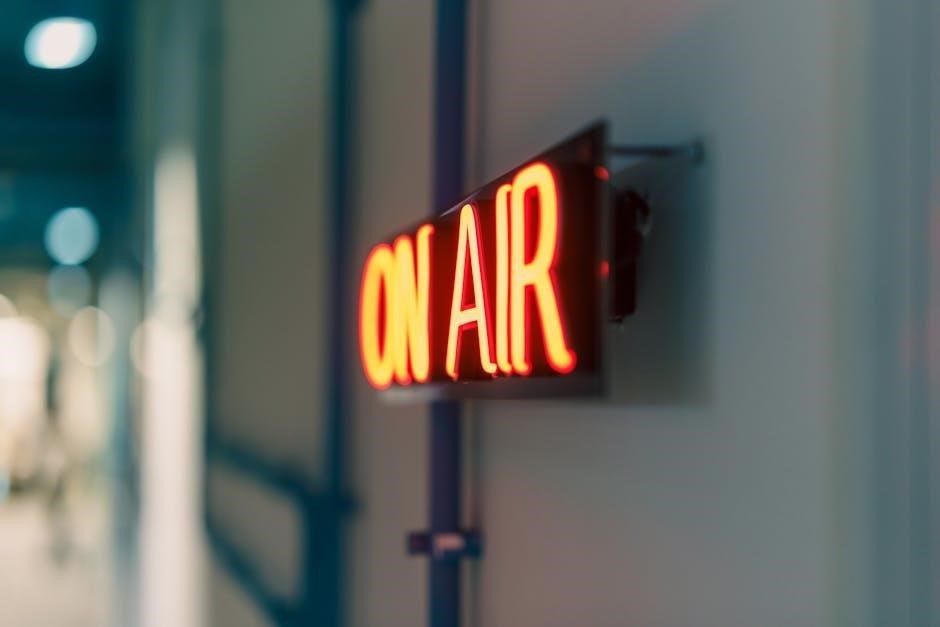
softball signs and signals pdf
Softball signs and signals are crucial for strategic communication, ensuring clarity and quick decision-making. They involve hand signals, verbal cues, and visual aids, essential for teamwork and gameplay. A softball signs and signals PDF guide provides detailed instructions, helping teams master these essential strategies effectively.
Definition and Purpose
Softball signs and signals are methods used by teams to communicate strategies and plays during games. They involve hand signals, verbal cues, and visual aids to convey instructions clearly and quickly. The primary purpose of these signals is to coordinate teamwork, execute plays effectively, and maintain strategic advantages. A softball signs and signals PDF guide provides a detailed overview of these methods, helping players and coaches understand and master the techniques. By standardizing communication, teams can ensure everyone is on the same page, enhancing overall performance and decision-making during gameplay.
Importance of Communication in Softball

Effective communication is vital in softball, as it ensures seamless coordination between players and coaches. Clear signals and cues prevent misunderstandings, allowing teams to execute plays efficiently. A softball signs and signals PDF guide emphasizes the role of communication in maintaining strategic advantages. By standardizing signals, teams can quickly relay information, enabling quick decisions during high-pressure situations. Proper communication fosters teamwork, reduces errors, and enhances overall performance. It is the backbone of successful gameplay, ensuring that every player is aligned and ready to act swiftly. This alignment is crucial for achieving victory and maintaining a competitive edge in the game.

Types of Softball Signs and Signals
Softball signs and signals include hand signals, verbal cues, and visual aids. A softball signs and signals PDF guide outlines these methods, enhancing team communication and strategy execution effectively.
Hand Signals
Hand signals are a fundamental form of communication in softball, used by coaches and umpires to convey strategies and decisions. They are precise and quick, ensuring clarity during gameplay. The softball signs and signals PDF guide details various hand signals, such as extending an arm with a fist or using a hammer motion, which indicate actions like “play ball” or “time out.” These signals are standardized, allowing teams to execute plays efficiently. Proper execution of hand signals is crucial for effective communication, and the guide provides visuals and explanations to help teams master them, enhancing overall performance and coordination on the field.
Verbal Cues
Verbal cues are a primary method of communication in softball, used by umpires and coaches to direct players and manage gameplay. These cues are clear and concise, ensuring immediate understanding. For example, umpires use phrases like “Play ball” or “Time out” to control the flow of the game. Coaches may use specific verbal signals to instruct players on strategies or base running. The softball signs and signals PDF guide outlines common verbal cues, such as “Safe” or “Out,” which are critical for umpires to communicate decisions effectively. Verbal cues enhance teamwork and coordination, making them an essential part of the game’s communication system.
Visual Aids
Visual aids in softball are essential for clear communication, particularly for umpires and players. These include hand signals, body gestures, and field indicators. Umpires use visual cues like pointing to fair territory or extending an arm to signal a dead ball. Coaches and players rely on visual signals for strategy, such as base coaches using hand gestures to direct runners. The softball signs and signals PDF guide details these visual aids, ensuring consistency and understanding. Visual communication is critical for gameplay flow, helping teams execute plays efficiently and umpires make accurate calls. It enhances coordination and reduces confusion during fast-paced games.
NFHS Official Softball Signals
NFHS official signals include gestures like extending the arm toward the pitcher or signaling “Play Ball.” These standardized cues ensure consistency and clear communication during games, as detailed in the softball signs and signals PDF.
Signal Toward Pitcher

The “Signal Toward Pitcher” is a key NFHS official gesture. It involves extending the left arm outward with a closed fist and palm down, directing attention to the pitcher. This signal is often accompanied by a verbal “Play Ball” call, indicating the start of play. Umpires use this to communicate clearly with players and ensure the game flows smoothly. As detailed in the softball signs and signals PDF, this signal is standardized to avoid confusion and maintain consistency across all games. Proper execution ensures effective communication, making it a fundamental part of softball officiating mechanics.
Play Ball Call
The “Play Ball Call” is a verbal signal used to restart play, typically after a timeout or between innings. It is often preceded by the “Signal Toward Pitcher,” where the umpire extends their left arm with a closed fist. This call ensures all players and officials are aware that the game is resuming. As outlined in the softball signs and signals PDF, consistency in this call is vital for maintaining game flow and preventing misunderstandings. Umpires must deliver the call clearly and audibly, making it a critical component of effective game management and communication.
Time Out/Foul Ball/Dead Ball Signals
Time Out, Foul Ball, and Dead Ball signals are essential for managing game flow. A timeout is signaled by extending the left arm with a closed fist, while a foul ball is indicated by a circular motion with the arm. Dead ball situations are marked by raising both arms to chest height. These signals ensure clarity and consistency, as outlined in the softball signs and signals PDF. Proper execution prevents confusion and maintains fair play. Umpires must deliver these signals decisively to keep the game moving smoothly and ensure all players understand the current state of play.
Safe and Out Calls
Safe and Out calls are critical for determining player outcomes. A safe call is signaled by extending the arm with an open hand, pointing toward the base. An out call involves a sweeping motion with the arm, ending in a clenched fist. These signals must be clear and decisive to avoid confusion. Umpires use consistent gestures to ensure accuracy, as outlined in the softball signs and signals PDF. Proper execution of these calls maintains game integrity and fairness. Teams rely on these visual cues to understand player status quickly, making them fundamental to effective gameplay and sportsmanship.

Stealing Signs in Softball
Stealing signs involves decoding opponents’ strategies to gain a competitive edge. Teams often decode catcher and coach signals, while coaches use indicators to protect their strategies. A softball signs and signals PDF guide can help teams understand and safeguard their communication effectively.

How Teams Steal Signals
Teams often steal signals by carefully observing the catcher’s and coaches’ signs. At higher levels, opponents may use sophisticated methods to decode strategies. Coaches use indicators, where one signal triggers the actual play. Teams must protect their signs by varying signals and using decoys. A softball signs and signals PDF guide can help teams understand these tactics and safeguard their communication. By mastering signal protection, teams can maintain a strategic edge and prevent opponents from gaining unauthorized advantages during the game.
Protecting Your Team’s Signs
Protecting your team’s signs is crucial to maintaining a strategic advantage. Teams should vary their signals regularly and use decoys to confuse opponents. Coaches can implement multiple signal systems, making it harder for others to decode. Additionally, limiting the visibility of signs and ensuring only authorized personnel know them helps prevent theft. A softball signs and signals PDF guide can provide tips on safeguarding communication. By being proactive and adaptable, teams can protect their strategies and stay ahead in the game, ensuring their signs remain effective and confidential.
Common Softball Signals
Common softball signals include infield fly, strike, and dead ball calls. These are visually indicated through specific hand gestures, ensuring clear communication during gameplay. A softball signs and signals PDF details these essential signals for reference.
Infield Fly Signal
The infield fly signal is a critical communication tool in softball, indicated by umpires touching their fingers together at chest height. This signal alerts the defense and offense of an infield fly situation, preventing confusion. It is typically given for every batter until the situation no longer applies. Umpires must pre-discuss this signal during pre-game meetings to ensure consistency. A softball signs and signals PDF guide provides detailed visuals and instructions for executing this signal accurately, helping teams and officials understand its proper application during gameplay.
Strike and Out Signals
Strike and out signals are essential for clear communication in softball. Umpires use specific hand gestures to indicate strikes and outs. For strikes, the umpire raises their right hand with a closed fist, while the left hand shows the number of balls. For outs, the umpire tips an imaginary cap. These signals must be consistent and visible to all players. A softball signs and signals PDF guide provides detailed illustrations of these gestures, ensuring umpires and players understand their proper execution. Proper signaling maintains game flow and fairness, emphasizing the importance of pre-game discussions to align on signal mechanics. Consistency is key to accurate calls.
Delayed Dead Ball Signal
The delayed dead ball signal is used to indicate a dead ball situation after a play has concluded. Umpires raise one arm straight up to signal a delayed dead ball, allowing the play to finish before stopping action. This ensures fair outcomes and prevents confusion. A softball signs and signals PDF guide details this signal, emphasizing its importance in maintaining game flow. Proper execution involves clear arm placement and timing, ensuring all players and umpires understand the call. This signal is crucial for managing game scenarios where immediate stops could lead to disputes or unfair advantages, highlighting the need for precise communication.

Mechanics and Umpire Signals
Umpires use hand signals, verbal calls, and visual aids to communicate effectively. Pre-game discussions ensure consistency in signals, with the plate umpire leading the process to maintain clarity and fairness.

Pre-Game Signal Discussion

A pre-game signal discussion is essential for umpires to ensure consistency and clarity. Led by the plate umpire, this meeting reviews all hand signals, verbal calls, and visual aids to be used during the game. Topics include infield fly signals, strike and out calls, and dead ball situations. This preparation helps prevent confusion and ensures smooth communication throughout the game. The discussion also covers proper mechanics and timing of signals, ensuring all umpires are aligned. This collaborative approach strengthens teamwork and maintains the integrity of the game, as outlined in the softball signs and signals PDF guide.

Plate Umpire’s Role
The plate umpire plays a critical role in managing the game and ensuring clear communication. They are responsible for calling strikes, outs, and safe or out calls at home plate. The plate umpire leads the pre-game signal discussion, reviewing all hand signals and verbal cues with the team. They must maintain consistency and accuracy in their calls, using official NFHS signals. The plate umpire also manages the game’s flow, ensuring timely decisions and clear communication. Their role is vital for fair play and maintaining the integrity of the game, as detailed in the softball signs and signals PDF guide.
Official Umpire Hand Signals
Official umpire hand signals are standardized to ensure clarity and consistency during the game. Key signals include extending the left arm with a fist, palm down, to indicate a dead ball, and using a fist-to-hammer motion for a strike or out. The plate umpire leads the pre-game discussion to review these signals, ensuring all officials are aligned. Proper execution of these signals is crucial for fair play and maintaining game flow. The softball signs and signals PDF guide provides detailed visuals and explanations of these official hand signals, helping umpires master their roles effectively.
Downloadable Resources
A softball signs and signals PDF guide is available for download, offering detailed instructions on essential signs, signals, and strategies. This free resource helps teams improve communication and gameplay effectively.
Softball Signs and Signals PDF Guide
A comprehensive softball signs and signals PDF guide is available for download, providing detailed insights into essential strategies and communication methods. This resource covers hand signals, verbal cues, and visual aids, ensuring teams can execute plays effectively. It includes official NFHS signals, stealing signs, and common signals like infield fly and strike calls. Coaches and players can benefit from clear instructions and diagrams, enhancing teamwork and gameplay. The guide is a valuable tool for mastering softball communication, helping teams gain a competitive edge. Download the PDF to improve your strategy and coordination on the field.
How to Use the PDF Guide
The softball signs and signals PDF guide is designed to be user-friendly, providing clear instructions for mastering communication strategies. Start by downloading the guide and reviewing its sections, which include hand signals, verbal cues, and visual aids. Practice the signals with your team during drills to ensure consistency. Use the guide to discuss pre-game strategies and refine your teamwork. The PDF is an invaluable resource for coaches and players, offering step-by-step explanations and diagrams to enhance understanding. By following the guide, teams can improve their communication and execution, leading to better performance on the field.
Mastering softball signs and signals enhances teamwork and strategy. The PDF guide provides essential tools for improving communication and gameplay, ensuring a strong competitive edge.
Mastering Softball Signs and Signals
Mastering softball signs and signals is key to enhancing teamwork and strategic gameplay. Teams that effectively communicate through hand signals, verbal cues, and visual aids gain a competitive edge. The softball signs and signals PDF guide provides detailed instructions and practical examples, helping players and coaches understand and execute signals accurately. By studying and practicing these signals, teams can improve coordination, reduce errors, and boost confidence. Additionally, the guide emphasizes the importance of adapting signals to opponents and protecting them from being stolen. Consistent practice and review of the PDF guide ensure teams stay ahead in the game.
Related posts:
Archives
Calendar
| M | T | W | T | F | S | S |
|---|---|---|---|---|---|---|
| 1 | 2 | 3 | 4 | 5 | 6 | 7 |
| 8 | 9 | 10 | 11 | 12 | 13 | 14 |
| 15 | 16 | 17 | 18 | 19 | 20 | 21 |
| 22 | 23 | 24 | 25 | 26 | 27 | 28 |
| 29 | 30 | 31 | ||||
Leave a Reply
You must be logged in to post a comment.